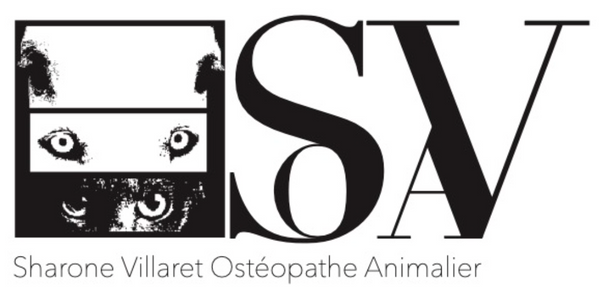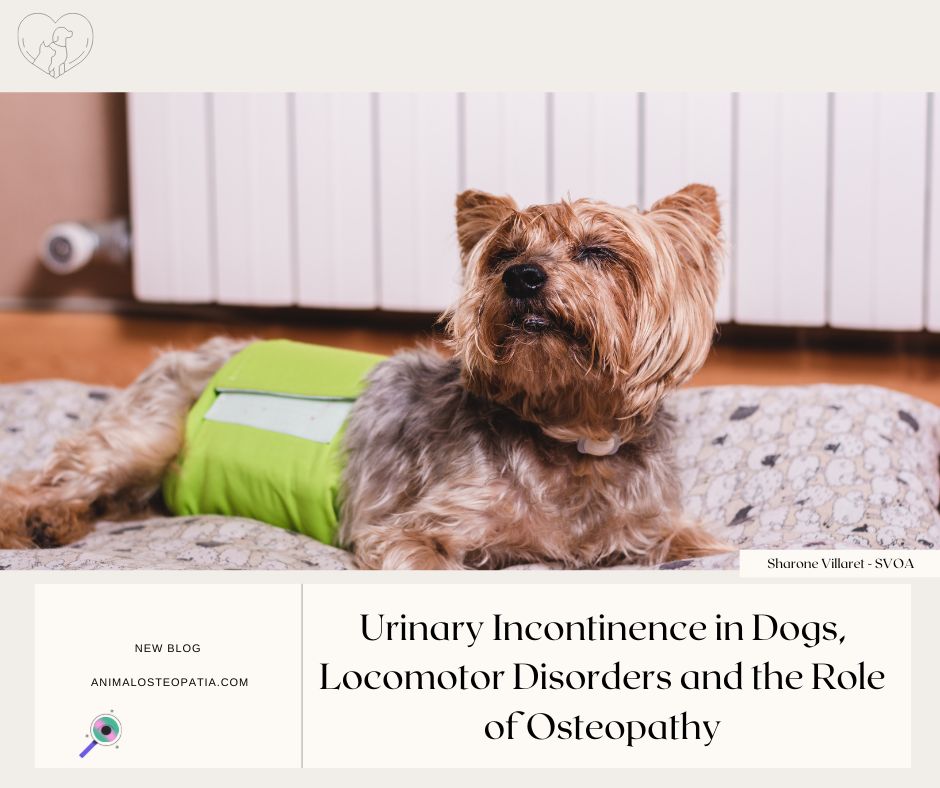Urinary incontinence is a common problem in dogs, affecting both young and older dogs. It can have several causes: hormonal, nervous, mechanical, or even traumatic. This disorder can be directly linked to locomotor disorders , particularly dysfunctions of the spine and the nerves controlling the bladder.
In this article, we will see:
✅ The main causes of urinary incontinence
✅ The link between locomotor disorders and urination
✅ How osteopathy can help improve your dog's continence and well-being
1. Understanding Urinary Incontinence in Dogs
Urinary incontinence is characterized by involuntary loss of urine. It can be:
🔹 Constant : The dog urinates without realizing it, even when resting.
🔹 Intermittent : Incontinence occurs at certain times (exertion, sleep).
🔹 Posture-related : When the dog moves, runs or lies down.
The causes of urinary incontinence are varied:
📌 Hormonal and Medical Causes
- Hormonal incontinence (often in spayed female dogs, due to a drop in estrogen).
- Chronic urinary tract infections irritating the bladder.
- Urinary stones causing involuntary leakage.
- Congenital malformations (ectopic ureters, urinary sphincter defect).
📌 Neurological Causes and Locomotor Disorders
- Compression of the sacral nerves (lumbosacral area of the spine).
- Lumbar disc herniations causing nerve disorders.
- Cauda equina syndrome causing pain and incontinence.
- Pelvic trauma affecting the nerve connections between the brain and bladder.
💡 A dog with locomotor problems may have urinary problems, because the same nerve areas control the bladder and hindquarters.
2. Link between Locomotor Disorders and Urinary Incontinence
Urination is under the control of the autonomic and voluntary nervous systems , involving several nerves:
🔹 Pudendal nerve : Controls the urinary sphincter (allows continence).
🔹 Pelvic nerve : Promotes bladder contraction for urine evacuation.
🔹 Hypogastric nerve : Keeps the bladder relaxed to store urine.
These nerves originate in the lumbosacral region of the spine. If compression, inflammation, or injury affects this area, the transmission of nerve signals to the bladder is impaired , resulting in urinary leakage.
💡 Postural abnormality, spinal blockage, or chronic limping can disrupt nerve communication between the brain and the bladder.
Connection between the Bladder Nerves and the Sacral Nervous System in Dogs
Urination is a complex process regulated by the nervous system , involving both the central nervous system (CNS) (brain and spinal cord) and the peripheral nervous system (PNS) (nerves directly controlling the bladder and sphincters).
The sacral plexus (L5 to S3 in dogs) is a key area for urination control. It groups together several nerves that provide communication between the spinal cord and the bladder , regulating both the retention and evacuation of urine.
📌 Nerves Involved in Urinary Function and Their Role
1. Pudendal Nerve: Control of the Urinary Sphincter (Continence)
- Origin : Spinal cord, segments S1 to S3 .
- Role : Allows voluntary contraction of the external urinary sphincter , thus preventing urine leakage.
- Malfunction :
🔹 If this nerve is damaged → Loss of sphincter tone , involuntary urinary leaks.
🔹 If this nerve is hyperactive → Urinary retention , difficulty urinating.
2. Pelvic Nerve: Contraction of the Bladder (Urinary Evacuation)
- Origin : Spinal cord, segments S1 to S3 .
- Role : Stimulates contraction of the detrusor muscle (bladder wall) to allow urine to be evacuated.
- Malfunction :
🔹 If this nerve is compressed → The bladder no longer contracts effectively, urinary retention .
🔹 If this nerve is damaged → Flaccid bladder, difficulty urinating or overflow incontinence (urine overflows involuntarily).
3. Hypogastric Nerve: Urinary Retention (Storage of Urine)
- Origin : Spinal cord, segments L1 to L4 .
- Role : Activates the sympathetic nervous system , inhibiting bladder contraction and promoting urinary retention by keeping the sphincter closed.
- Malfunction :
🔹 If this nerve is hyperactive → Urinary blockage , difficulty completely emptying the bladder.
🔹 If this nerve is damaged → Excessive relaxation, causing incontinence .
📌 Associated Vertebrae and Their Impact on Urination
The nerves responsible for urinary function emerge primarily from the lumbosacral region of the spine. Compression, blockage, or inflammation in this area can disrupt nerve transmission to the bladder.
🔹 L1 to L4 → Hypogastric nerve (urinary retention)
🔹 S1 to S3 → Pudendal nerve (control of the urinary sphincter) and pelvic nerve (contraction of the bladder)
📍 Spinal disorders that may affect urination:
✔ Lumbosacral disc herniation → Compression of the pelvic and pudendal nerves, causing incontinence or difficulty urinating.
✔ Cauda equina syndrome → Damage to the sacral nerves, causing urinary and locomotor problems.
✔ Lumbar spondylosis → Vertebral osteoarthritis limiting mobility and disrupting nerve transmission.
✔ Subluxation of the pelvis or sacrum → Blocks good nerve conduction to the bladder.
💡 A dog with incontinence associated with locomotor problems (back weakness, lameness, lower back pain) should be evaluated for possible spinal involvement.
3. Osteopathy: A Natural Help for Urinary Incontinence in Dogs
Canine osteopathy is a manual therapy that aims to rebalance the body by working on the joints, muscles, fascia and nervous system.
📌 How Does Osteopathy Help an Incontinent Dog?
🐾 In case of incontinence linked to a locomotor disorder :
✔ Release of tension in the lumbosacral region to improve nerve conduction to the bladder.
✔ Correction of spinal misalignments that can compress the nerves responsible for urination.
✔ Work on posture and muscle balance to reduce painful compensations that aggravate the problem.
🐾 In case of hormonal or idiopathic incontinence :
✔ Improved tissue vascularization to optimize urinary sphincter tone.
✔ Stimulation of the pelvic and pudendal nerves to promote better bladder control .
✔ Fascia release techniques to reduce tension on the pelvic organs.
📌 Recommended Osteopathic Protocol
🔹 Initial session to assess locomotor and nervous imbalances.
🔹 Specific work on the pelvis, the lumbosacral spine and the pelvic diaphragm .
🔹 Regular monitoring to maintain postural and nervous balance.
💡 Osteopathy does not replace veterinary treatment, but it is a valuable complementary solution to restore continence and improve the dog's quality of life.
4. Conclusion
Urinary incontinence in dogs can be caused by hormonal, medical, or neurological factors related to locomotor disorders . Compression of the nerves in the lower back can disrupt communication between the brain and the bladder, leading to urinary leakage.
💡 Osteopathy is an effective natural aid to relieve tension, improve nerve transmission, and optimize the well-being of incontinent dogs. 🐶💙
Click here to make an appointment with my osteopath for my dog in Portugal!


Sharone Villaret - Animal Osteopath


